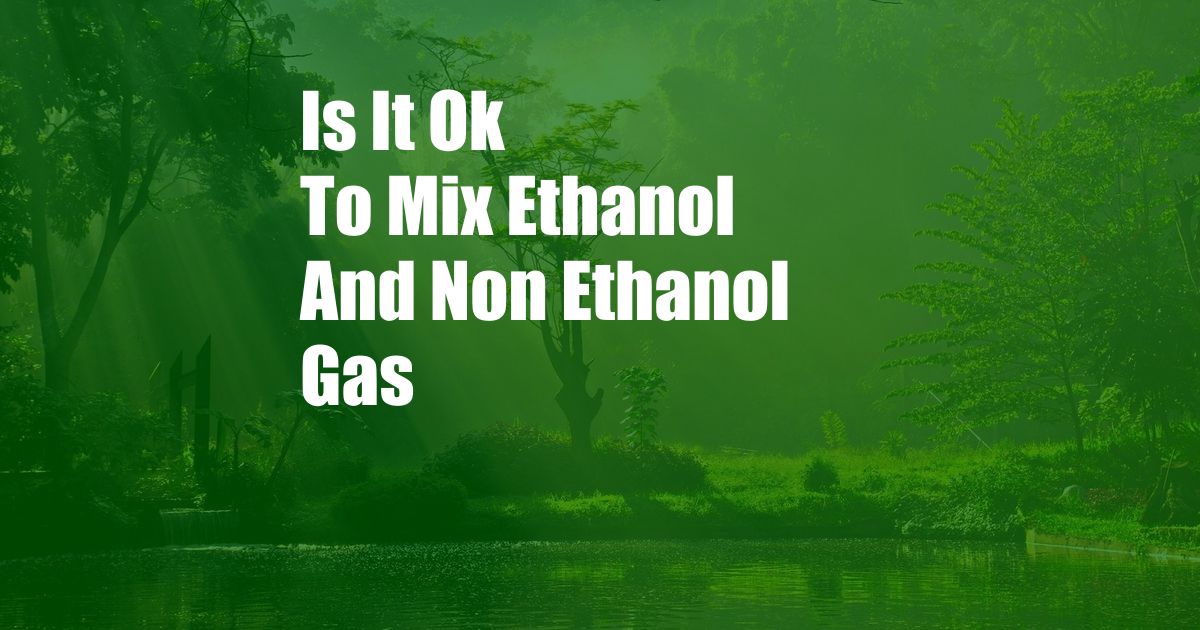
Is It Okay to Mix Ethanol and Non-Ethanol Gas?
In the realm of automotive fueling, the question of whether it’s safe to mix ethanol and non-ethanol gas has sparked a fervent debate. As an avid car enthusiast, I’ve delved into the depths of this topic, seeking clarity and unraveling the complexities that surround it. In this comprehensive guide, we’ll embark on a journey to uncover the truth, exploring the implications, and providing expert insights to empower you with a well-informed decision.
Let’s kickstart our exploration with a brief overview of ethanol and its role in the automotive industry.
Understanding Ethanol and Its Purpose
Ethanol, an alcohol-based fuel, has gained prominence as a renewable alternative to traditional gasoline. Derived from plant-based sources such as corn or sugarcane, it’s blended with conventional fuel to reduce greenhouse gas emissions and enhance octane levels, contributing to improved engine performance and reduced fuel consumption. However, the compatibility of ethanol with non-ethanol gasoline remains a topic of discussion.
Compatibility Concerns and Ethanol Content
The compatibility of ethanol and non-ethanol gasoline depends on the concentration of ethanol in the blend. Low-level ethanol blends, typically containing up to 10% ethanol (E10), are generally considered safe for use in most vehicles. However, higher ethanol concentrations, such as E15 and E85, may require specific vehicle modifications to ensure optimal performance.
E15, a blend containing 15% ethanol, is approved for use in vehicles manufactured after 2001. However, older vehicles may experience compatibility issues, including engine damage and fuel system corrosion. E85, a blend with a significantly higher ethanol content (51-83%), is reserved for flex-fuel vehicles specifically designed to handle its higher ethanol concentration.
Assessing Your Vehicle’s Compatibility
Before mixing ethanol and non-ethanol gas, it’s crucial to determine your vehicle’s compatibility. Refer to your owner’s manual, consult with your vehicle manufacturer, or utilize online resources that provide compatibility information based on your vehicle’s make, model, and year.
Using incompatible fuel blends can lead to a range of issues, including reduced engine power, increased fuel consumption, and premature component failure. It’s essential to adhere to the recommended fuel specifications outlined by your vehicle’s manufacturer to maintain optimal performance and longevity.
Expert Advice for Safe Mixing
If your vehicle is compatible with ethanol blends, it’s important to follow these expert tips to ensure safe mixing:
- Gradual Introduction: Begin by adding small amounts of ethanol-blended fuel to your tank, gradually increasing the proportion over several fill-ups. This allows your vehicle to adapt to the changes in fuel composition.
- Regular Fuel System Maintenance: Ethanol can act as a solvent, potentially dislodging deposits and debris in the fuel system. Ensure proper maintenance, including regular fuel filter changes, to avoid clogging
Frequently Asked Questions
Q: Can I mix ethanol and non-ethanol gas in any proportion?
A: No, the compatibility of ethanol blends varies depending on your vehicle’s specifications. Always refer to your owner’s manual or consult with your vehicle manufacturer for guidance.
Q: What are the long-term effects of using ethanol blends?
A: Studies have shown that low-level ethanol blends (E10) have minimal long-term impacts on vehicle performance and reliability. However, higher ethanol concentrations (E15 and E85) may require more frequent maintenance or modifications to ensure compatibility.
Q: Is it better to use ethanol or non-ethanol gas?
A: The choice between ethanol and non-ethanol gas depends on your vehicle’s compatibility and your personal preferences. Ethanol blends can offer environmental benefits and enhanced octane levels, while non-ethanol gas may provide better fuel economy in some cases.
Conclusion
Mixing ethanol and non-ethanol gas can be a viable option for compatible vehicles, provided it’s done carefully and gradually. By understanding the compatibility requirements, utilizing expert advice, and adhering to proper fuel system maintenance, you can safely leverage the potential benefits of ethanol blends while preserving your vehicle’s performance and longevity. As always, consult with your vehicle’s manufacturer for specific recommendations and to ensure optimal results.
Are you curious to learn more about automotive fuel and its implications? Let us know in the comments below, and we’ll be delighted to continue the conversation.